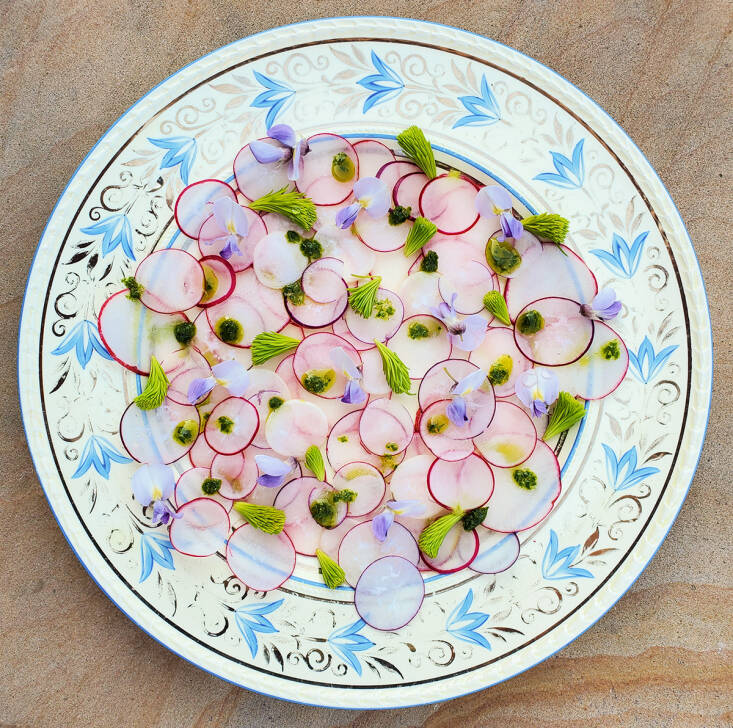Perhaps, like me, you were warned as a child not to eat the green “beans” of wisteria—those large, velvety pods that form after the twining vine has dropped its voluptuous clusters of flowers. But did the cautious adult keeping you safe let you know that the perfumed, pea-like blooms of wisteria are a sweet treat, and safe to eat? Probably not. So let your inner child rejoice: When wisteria begins to cascade in delectable scent wherever you live, collect a tender handful—for your glass, and for your lunch. Here’s how to make wisteria syrup.
Photography by Marie Viljoen.

Few spring events are as evocative as wisteria in bloom. In late spring the vine’s musky trusses of blossoms are strikingly beautiful (which is why Asian species were imported to North America from Japan and China. They are now considered invasive, since they twine around anything vertical, shading-out other plants and sometimes girdling and killing less robust species).

Native to the lower Midwest, the Southeast, and the eastern parts of the US, Wisteria frutescens is a better choice for North American gardens. Its racemes of flowers are noticeably fore-shortened and opulently compact, and its scent and color are deeply appealing. (It also blooms after the vine has leafed out, rather than on bare branches, giving the amethyst an effective frame of green.)

All species of wisteria have edible flowers. Like the pea flowers they resemble, they are noticeably sweet, and have a yieldingly crisp texture. Their scent is remarkable. The rest of the plant is considered toxic. Avoid the leaves, stems, and those tempting bean-like pods.

Suspended in ice cubes for long, cool drinks, wrapped inside translucent rice paper for summer rolls, or scattered onto salads, fresh wisteria blossoms are enchanting. I preserve these flowers mainly in the form of a wisteria syrup, and a vinegar (wildly fruity and aromatic), both of which I eke out during the year, in drinks and also in cooked or baked dishes.


To collect wisteria blossoms pick the open flowers individually from the tops of the clusters, leaving the rest, lower down, to open over a few days. Or, if you pick the entire cluster, use the scented, mature flowers for infusions, and the closed buds in salads and wraps, or for quick pickles. For the best perfume, collect wisteria in the morning or at night. Do not wash. But do give the flowers a shake to evict ants!

Concentrated Wisteria Syrup
(From Forage, Harvest, Feast – A Wild-Inspired Cuisine, Chelsea Green Publishing, 2018)
Makes 2 cups
The ephemeral perfume of wisteria is caught in this strong syrup, because no heat destroys its delicate taste. Drizzle it sparingly over panna cotta, rice pudding, cupcakes and tea cakes, and into drinks.
- 4 cups sugar
- 2 cups water
- 5 ounces (about 25 flower clusters) open wisteria flowers, stripped from stalks
Combine the sugar and water in a saucepan over medium heat. Bring to a boil, stirring well. Once all the sugar has dissolved, turn off the heat and let cool completely. Place the open flowers in a clean jar. Pour the cool syrup over them, stir, and cover the jar. Let steep for 24 hours. Strain the syrup from the flowers and transfer to a clean bottle. Store in the fridge. It keeps at least a year.
(If you’d like to make a fermented syrup, follow the instructions for Elderflower Cordial, substituting wisteria blossoms for the elder.)


Wisteria, Lime, and Sake Popsicles
(Adapted from Forage, Harvest, Feast – A Wild-Inspired Cuisine, Chelsea Green Publishing, 2018)
Makes 10 Popsicles
These adult popsicles are a magical end to an early summer meal. Nigori (cloudy) sake and lime are a divine pairing for wisteria syrup. For faster freezing make sure all your ingredients are very cold.
- 1 cup chilled Nigori sake
- ½ cup cold Concentrated Wisteria Syrup
- ½ cup cold lime or lemon juice
- ¼ ounce wisteria flowers (optional)
Combine the sake, Concentrated Wisteria Syrup, and lime juice in a large jug. Taste—it should be sweet with a balance of tartness. If your sake is on the drier side, add a touch more syrup. If you are using flowers, drop a few wisteria blossoms into your popsicle molds. Fill the molds by a quarter and transfer to the freezer for a couple of hours (keep the rest of the sake mixture in the fridge). Add some more flowers, and some more liquid. Return to the freezer for another hour, or until the new layer has frozen. Remove again and add the popsicle sticks (if you are using wooden sticks), some more flowers, and the rest of the sake mixture. Or skip the flowers altogether for faster process.
When they are frozen solid release the popsicles by dipping the mold into warm water for a couple of seconds. Start licking!
See also:
- Sour Grapes: An Under-Appreciated Ancient Ingredient
- Summer Solstice Elderflowers (in Cape Town)
- Cornelian Cherry: A Cornucopia of Edible Uses












Have a Question or Comment About This Post?
Join the conversation (0)